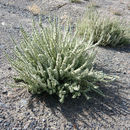en
names in breadcrumbs


Halogeton is a plant genus of the family Amaranthaceae. The genus name, Halogeton, derives from the Greek words for "salt" and for "neighbor."[1]
The genus Halogeton includes both annual and perennial species. The leaves are fleshy cylindrical, terminating in a persistent or caducous bristle. There are three to several flowers in the axil of each floral leaf. The perianth segments are membranous. The stamens are fixed on a papillose staminodial disk. In fruit, the tepals develop five wings.
The annual species grow in temperate salines and ruderal places, while the perennials are found in warm and hot deserts. They are tolerant of fairly saline soils.
Halogeton sativus was cultivated for the enormous 18th Century barilla industry in Spain that produced soda ash. The species was considered to be a "saltwort" plant.
Halogeton glomeratus is considered a noxious weed in most regions of the United States;[2] a particular difficulty with H. glomeratus is that it is poisonous to sheep, and possibly to cattle, due to the high concentration of sodium oxalate in the dry plant.[3] The common names for H. glomeratus include halogeton (the same as the genus), barilla, and saltlover.[4]
Halogeton species are used as food plants by the larvae of some Lepidoptera species including The Nutmeg and the Coleophora case-bearers C. klimeschiella and C. parthenica.
The genus Halogeton was published in 1829 by Carl Anton von Meyer (in Ledeb., Icon. Pl. Fl. Ross. 1: 10), with the type species Halogeton glomeratus (M. Bieb.) C.A.Mey. Synonyms are Agathophora (Fenzl) Bunge and Micropeplis Bunge. The genus includes about 5 species:
Hossein Akhani, Gerald Edwards, Eric H. Roalson:Diversification Of The Old World Salsoleae S.L. (Chenopodiaceae): Molecular Phylogenetic Analysis Of Nuclear And Chloroplast Data Sets And A Revised Classification In: International Journal of Plant Sciences, 168(6), p. 942 and 945-946, 2007. (chapters Description, Habitat, Systematics)
Halogeton is a plant genus of the family Amaranthaceae. The genus name, Halogeton, derives from the Greek words for "salt" and for "neighbor."
Halogeton es un género de plantas herbáceas de la familia Amaranthaceae.[1] Comprende 27 especies descritas y de estas, solo 4 aceptadas.[2]
Son hierbas anuales o arbustos con carnosas hojas alternas. Hojas semi-cilíndricas para subglobular, sésiles, mucronadas, la mayoría termina en unas cerdas duras. Flores hermafroditas y pistiladas juntos, amontonados en las axilas entre lana densa, los laterales con 2-3 bracteolas. Perianto 5, casi libre, sin el nervio central, el exterior 2 o 3 (rara vez) todo gibosa o alas en la parte posterior de la fruta. Estambres (2-3 -) 5; anteras con apéndices cortos o no; estaminodios 4-5, alternando con los estambres. Frutas (utrículo) incluido en perianto con pericarpo adherente, membranoso, las semillas verticales (u horizontales), ex albuminosas.
El género fue descrito por Carl Anton von Meyer y publicado en Icones Plantarum 1: 10, pl. 40. 1829.[3] La especie tipo es: Halogeton glomeratus (M.Bieb.) Ledeb.
A continuación se brinda un listado de las especies del género Halogeton aceptadas hasta octubre de 2012, ordenadas alfabéticamente. Para cada una se indica el nombre binomial seguido del autor, abreviado según las convenciones y usos.
Halogeton es un género de plantas herbáceas de la familia Amaranthaceae. Comprende 27 especies descritas y de estas, solo 4 aceptadas.
Halogeton é um género botânico pertencente à família Amaranthaceae.[1][2]
Halogeton é um género botânico pertencente à família Amaranthaceae.
Halogeton là chi thực vật có hoa trong họ Amaranthaceae.[1]
Halogeton là chi thực vật có hoa trong họ Amaranthaceae.
盐生草属(学名:Halogeton)是藜科下的一个属,为一年生草本植物。该属共有3种,分布于亚洲中部及酉部。[1]